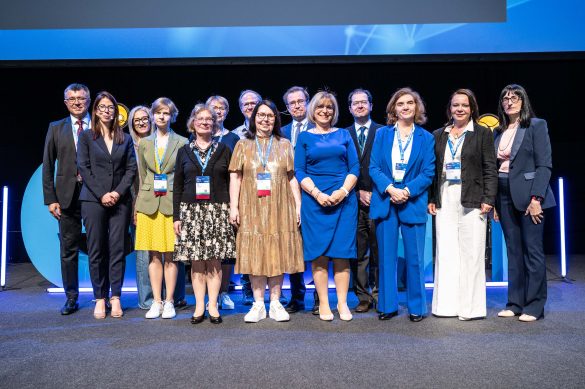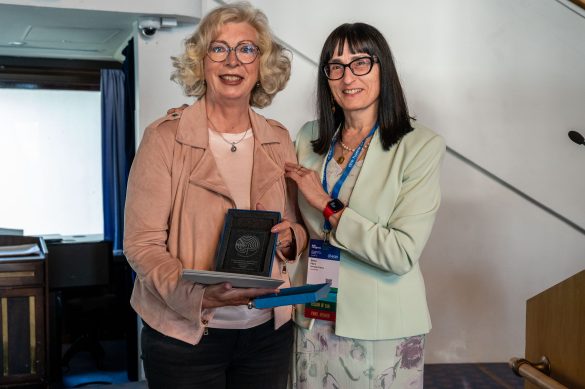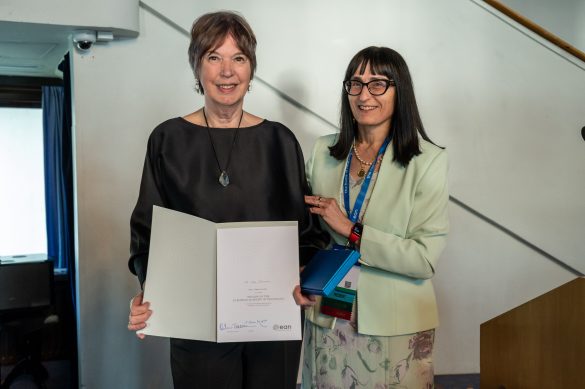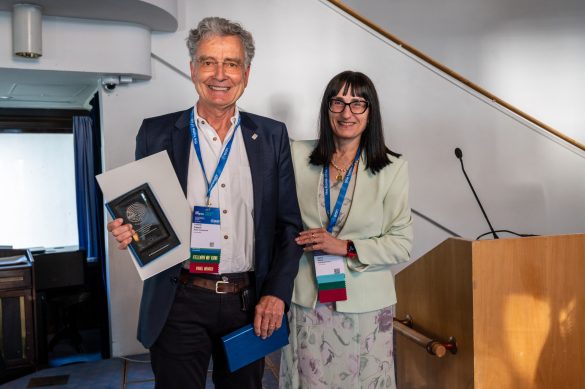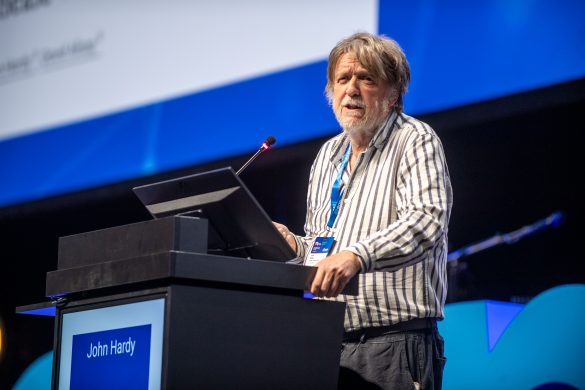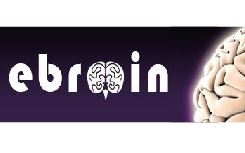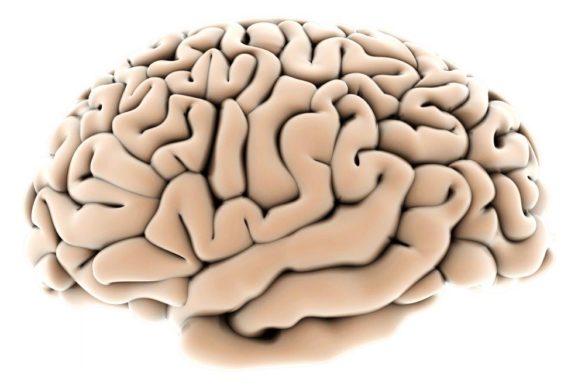presented by João Martins and Luís Santos
We report the case of a 75-year-old lady who at the age of 25 initiated slowly progressive proximal paresis of lower limbs, and became dependent of a wheelchair when 30 years old. At 55 proximal paresis of upper limbs began and three years later she complained of ventilatory dysfunction predominantly due to diaphragmatic paresis – progressing, years later, to severe restrictive pattern needing BiPAP (Figure 1 – Clinical Chronogram). Recently she was diagnosed with paroxysmal atrial fibrillation and 1st degree AV block but no relevant structural cardiac abnormalities were found.
The performed EMGs showed a myopathic pattern. Many years earlier, two previous Deltoid biopsies gave inconclusive results due to severe muscular destruction and marked adipose and connective tissue infiltration. At that time, she refused more invasive diagnostic procedures and was not rendered a specific clinical diagnosis.
At present (Figure 2 – MRC Functional Muscular Map), she has relatively spared extensor muscles of the wrist and fingers, hip abductors, and toes’ flexors, with severe muscle atrophy and weakness of most of the other muscles (Figure 3 – Patient Pictures), being now bedridden all day long.
Her family tree is depicted in Figure 4. Her parents were not related. She had a sister with a similar clinical phenotype who died in her 70s, also without a specific diagnosis. The patient was married to a first degree cousin and had 5 children: 4 sons (one stillbirth and three floppy babies, who died in the first year of life of unknown cause) and one healthy daughter.
Thinking of an autosomal recessive disease, LGMD phenotype with ventilatory dysfunction and initial diaphragmatic involvement, Pompe disease was recently screened in Hamburg using a dried blood spot (DBS) that showed normal alpha-glucosidase activity, at pH 3.8 with acarbose inhibition (2.21nmol/spot*21h; Normal range: 0.9–7.2), likely excluding this diagnosis.
Based on her clinical relative muscle sparing in the forearm extensor group, and after patient consent, a new muscle biopsy was now performed, at the age of 75 and fifty years after clinical onset of disease, sampling the Extensor digitorum communis. This exam showed typical dystrophic findings, absence of immunohistochemical labelling for dysferlin, with normal staining for sarcoglycans, dystroglycans and dystrophin. Interestingly even now but as sometimes seen in inflammatory dystrophies the biopsy also showed scattered MHC-I up-regulation and some perimysium and perivascular inflammatory infiltrates (Figure 5 – Muscle Biopsy).
We then proceeded to molecular testing and the mutation DYSF: c.610C>T (p.Arg204X) was found, apparently in homozygosis in exon 6, confirming the diagnosis of LGMD type 2B.
Comment by the authors:
This case illustrates the selective relative sparing of certain muscle groups after 50 years of clinical progression of LGMD-2B allowing even then a diagnosis by muscle biopsy and posterior genetic testing.
There is now good evidence that MRI can be very useful in selecting the appropriate muscles for biopsy and also in determining the type of muscular dystrophy through pattern recognition of muscle involvement by the use of MRI muscle maps (1). In this case, MRI muscle maps would not be helpful due to the actual extensive muscle destruction. For biopsy guidance we want to stress that in an era of global economic crisis and low health resources a careful neurologic examination may sometimes suffice.
The presence of inflammatory findings is well described in several muscular dystrophies such as Duchenne, and can be seen in dyspherlinopathies (2). MHC-I detection alone cannot be used as a reliable diagnostic test to differentiate inflammatory myopathies from dystrophies with secondary muscle inflammation and some authors support testing for CD8/MHC-I Complex for differentiation (3,4).
In this case, besides the absent dyspherlin immunostaining, these inflammatory findings could pose diagnostic uncertainty and also ethical concerns about the possibility of a missed treatable condition early on. For that purpose molecular testing is essential. Determining the subtype and etiology of muscle disease in patients with LGMD phenotype is fundamental for genetic counselling, cardiac/respiratory monitoring, further research and therapy.
One final issue that still lacks an explanation is: why did the patient have a stillbirth and three floppy babies that died in their first months of life? LGMD-2B usually does not manifest clinically that way, so we do not think that this curious event is due to this particular type of muscular dystrophy. She married a first degree cousin, so we cannot exclude that they were both carriers of another pathogenic gene.
1. A short protocol for muscle MRI in children with muscular dystrophies. Mercuri E, et al. Eur J Paediatr Neurol 2002; 6(6):305-7
2. Muscle inflammation and MHC class I up-regulation in muscular dystrophy with lack of dysferlin: an immunopathological study. Confalonieri P, Oliva L, et al. J Neuroimmunol. 2003; 142(1-2):130-6
3. CD8/MHC-I Complex is Specific but not Sensitive for the Diagnosis of Polymyositis. T-J Dai, W Li, et al. J Int Med Res 2010; 38: 1049-59
4. Review: An Update on Inflammatory and Autoimmune Myopathies. M C Dalakas. Neuropath Appl Neuro 2011; 37: 226-42
João Martins works at the Departments of Neurology at Hospital Pedro Hispano, ULSM in Matosinhos and Hospital de Egas Moniz, CHLO in Lisbon, Portugal.
Luís Santos works at the Departments of Neurology at Hostpial de Egas Moniz, CHLO in Lisbon and Hospital Fernaando Fonseca in Amadory, Portugal.
Comment by Janez Zidar
In contrast to their quite homogeneous clinical presentation, limb-girdle muscular dystrophies (LGMD) are genetically rather heterogeneous diseases; already the group of autosomal recessively inherited LGMD consists of 16 different disease categories. The usual diagnostic approach is to consider the age at onset, initial disease symptoms, pattern of muscle involvement, clinical course, impairment of the respiratory and heart muscles, and laboratory characteristics, e.g. serum CK activity, EMG pattern, muscle imaging, and muscle biopsy findings. Careful evaluation of these data may eventually direct the selection of molecular genetic diagnostic tests. Such scheme is in principle more effective in considering patients in whom the disease is still in its early stage. In later stages, as in the case presented, some facts from the history might be forgotten or less clear. The distinctive features of muscle involvement, typical of one or the other disease, are lost, as – with progression of the disease – muscles become more generally affected. Serum CK activity that might have initially been characteristically high, has declined to low or even normal values. Muscle tissue for histological and biochemical investigations may be more difficult to obtain because of the widespread replacement of muscle by fat and fibrous tissues.
This logic first led the authors to think of Pompe’s disease, as – not systematically enough – they only took into account the presumed autosomal recessive inheritance, LGMD phenotype, and ventilatory dysfunction. The initial diagnosis was not confirmed. By considering clinical data more analytically, the probability of establishing the diagnosis on clinical grounds is likely to increase. Such reasoning may not be necessary in neuromuscular diseases with distinct clinical presentations, but is valuable in groups of diseases with significant genetic and clinical heterogeneities, to which LGMD undoubtedly belongs. I would like to illustrate this by the analysis of the case presented in this Grand Round, though it may not be the best example for the task, as it – in many respects – represents a rather atypical case of dysferlinopathy.
LGMD2B or dysferlinopathy is the disease caused by mutations in the dysferlin gene. With 18.7% of cases, it was the second most frequent form of LGMD in a large cohort of Italian patients (2). Dysferlinopathies most commonly occur in the second or third decades of life, but the age of onset may vary considerably (2). The disease in the case presented started at the age of 25 what matches expectations. The rate of progression is usually slow and many people remain ambulant (2,3,6). This is not true for the presented case and other rare cases from the literature (6) in whom the progression may be rapid with severe affection of upper limbs and axial muscles, and loss of ambulation within the first 5 years after disease commencement.
The severity and pattern of muscle involvement may vary even in cases with the same mutations. Some patients complain of muscle pain and swelling in the legs, especially the calves. The patients’ presenting symptoms and signs were muscle atrophies and weakness with the LGMD distribution. This phenotype is only seen in a rather small percentage of patients. In about two thirds or more (6) the lower limbs especially the calf muscles are atrophic and weak already from the onset, either alone (Miyoshi type of muscular dystrophy) or in combination with the proximal ones (6). Such findings are in contrast to those in most other limb-girdle muscular dystrophies in which calf muscle hypertrophy or pseudohypertrophy dominates. On examination atrophy and weakness of the posterior leg muscles are discovered even in patients with proximal limb and anterior tibial muscle involvement. Of some help in making clinical diagnosis in dysferlinopathies is the early loss of the Achille’s tendon jerks. They are typically the last to be lost in other limb-girdle muscular dystrophies.
Significant heart problems in LGMD2B appear to be rare (2,5). Whether paroxysmal atrial fibrillation and the 1st degree AV block found in the patient may be considered a part of muscular dystrophy could not be resolved. Rare LGMD2B patients may experience breathing difficulties (5,6) due to the respiratory muscle weakness. These problems are usually less severe than in other muscular dystrophies. A quick search of the literature did not reveal any report on a case in which non-invasive artificial ventilation was needed as it was in the patient in question.
The noticeable characteristic of dysferlinopathies is undoubtedly a massive increase of serum CK activity. If patients present with phenotypic characteristics of dysferlinopathy the first advised step towards the diagnosis is the determination of serum CK. It is therefore surprising that the authors did not provide us with this information. It is unlikely that it was not available for them. It may be added that CK values in Pompe’s disease are less increased and may be, in adult patients, even normal. This disease is also well known as the so-called “irritative myopathy” presenting with fibrillation potentials, complex repetitive and myotonic discharges which is in contrast to dysferlinopathy where such spontaneous activity is not expected. The authors of this case report do not point out spontaneous activity. Muscle ultrasonography, CT or MRI imaging can disclose calf and also hamstrings muscle involvement even in cases presenting with CKemia or distal leg painful muscle swelling (5,6). Such specific findings may significantly facilitate the diagnosis. Inflammatory histological findings are other distinct characteristics of the disease, as commented upon by the authors. It may be added that there are quite a number of reports in the literature of such patients unsuccessfully treated by corticosteroids and/or immunosuppressive drugs (6) and many of us know such cases from our own practice.
The most typical phenotype of the LGMD2B (e.g. early distal lower limb muscle involvement, high serum CK values) is so unique that it is difficult to confuse it with other muscular dystrophies. Misdiagnosis is more common in patients with proximal limb weakness than in those with the initial distal posterior compartment involvement in the legs (6). Recently a new type of LGMD (LGMD2L – mutations in the anoctamin gene) was described that may present with the same features and may be mistaken with dysferlinopathy (1,8). There is also the third locus of the Miyoshi distal muscular dystrophy on chromosome 10p (4).
LGMD2B is an autosomal recessive condition. Patients have two defective copies of the dysferlin gene while their parents – asymptomatic but carriers of the disease – have only one such copy. The frequency of carriers in population is not known but is believed to be small. This makes the chance of LGMD2B patients having affected children very low what may not be true if the patient and his partner are related. The latter increases the likelihood of the spouse to have one of the gene copies faulty and raises the probability for that couple to have affected children to 50%. The presenters of the case in this Grand Round are right in saying that LGMD2B is not expected to present with stillbirth or death in the first months of life. However, a congenital form of this disease, resembling congenital muscular dystrophy, has been reported (7). A non-consanguineous family with two affected siblings was found in whom the new disease phenotype was characterized. It consisted of postnatal hypotonia, delay in motor development and marked weakness of pelvic and neck flexor muscles. Progression of the disease was slow. A homozygous frameshift mutation p.Ala927Leu-fsX21 in the dysferlin gene was identified in both siblings. Same pathogenic mutation has been found earlier and could be associated with different disease phenotypes, including asymptomatic hyperCKemia. These two patients with congenital LGMD2B widen the clinical spectrum of this disease, which can be used as an argument that the patient presented in this Grand Round, her late children and other family members, if their tissue specimens were still available, would be worth studying. It is namely not unrealistic to hypothesise that the affected children of this family might have also been affected by LGMD2B.
References
1. Bolduc V, Marlow G, Boycott KM, Saleki K, Inoue H, Kroon J, et al. Recessive mutations in the putative calcium-activated chloride channel Anoctamin 5 cause proximal LGMD2L and distal MMD3 muscular dystrophies. Am J Hum Genet 2010; 86; 213-21.
2. Guglieri M, Magri F, D’Angelo MG, Prelle A, Morandi L, Rodolico C, et al. Clinical, molecular, and protein correlations in a large sample of genetically diagnosed Italian limb girdle muscular dystrophy patients. Hum Mutat 2008; 29(2): 258-66.
3. Linssen WH, Notermans NC, Van der Graaf Y, Wokke JH, Van Doorn PA, Howeler CJ, et al. Miyoshi-type distal muscular dystrophy: clinical spectrum in 24 Dutch patients. Brain 1997; 120(Pt 11): 1989-96.
4. Linssen WH, de Visser M, Notermans NC, Vreyling JP, Van Doorn PA, Wokke JH, et al. Genetic heterogeneity in Miyoshi-type distal muscular dystrophy. Neuromuscul Disord 1998; 8: 317-20.
5. Mahjneh I, Marconi G, Bushby K, Anderson LV, Tolvanen-Mahjneh H, Somer H. Dysferlinopathy (LGMD2B): a 23-year follow-up study of 10 patients homozygous for the same frameshifting dysferlin mutations. Neuromuscul Disord 2001; 11: 20-6.
6. Nguyen K, Bassez G, Krahn M, Bernard R, Laforet P, Labelle V, Urtizberea JA, et al. Phenotypic study in 40 patients with dysferlin gene mutations. Arch Neurol 2007; 64: 1176-82.
7. Paradas C, Gonzáles-Quereda L, De Luna N, Gallardo E, Garcia-Consuegra I, Gomez H, et al. A new phenotype of dysferlinopathy with congenital onset. Neuromuscul Disord 2009; 19: 21-5.
8. Penttila S, Palmio J, Suominen T, Raheem O, Evila A, Muelas Gomez N, et al. Eight new mutations and the expanding phenotype variability in muscular dystrophy caused by ANO5. Neurology. 2012; 78: 897-903.
Janez Zidar is Professor of Neurology at the Institute of Clinical Neurophysiology of the University Medical Centre Ljubljana in Slovenia.

